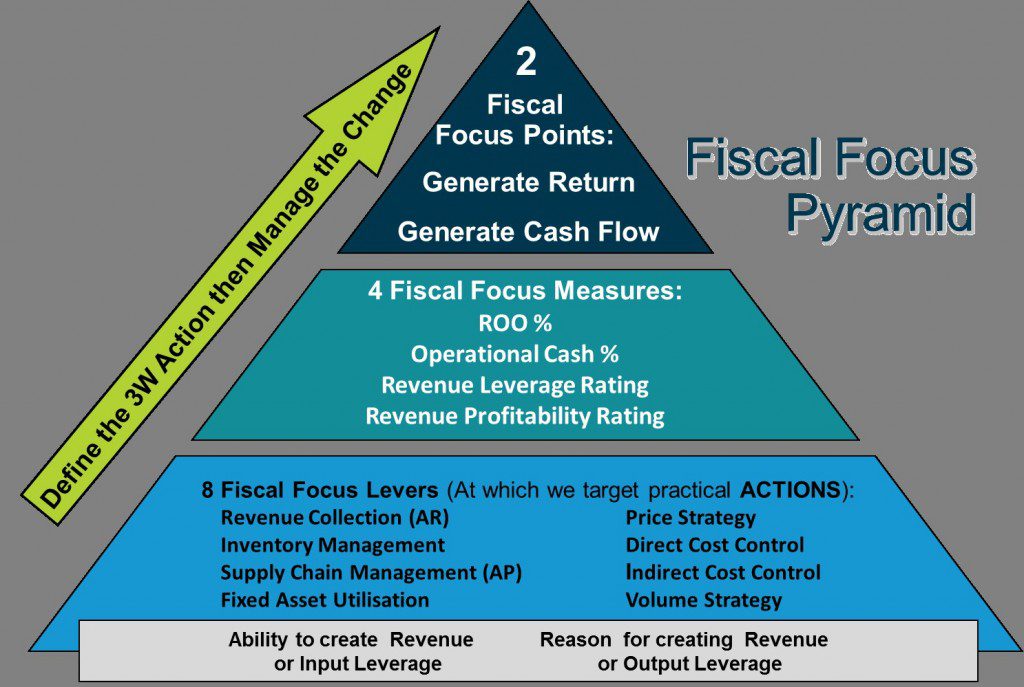Core Management Principle 2 – Fiscal Focus
Do you and your executives truly understand all the numerical information provided by your accountant? In my experience, most don’t. But with Fiscal Focus, you can!
Having a background in accounting, I’m lucky enough to understand double entry bookkeeping. Traditional accounting methods such as this are handy for reporting business data to agencies like the tax authorities. But the way the information is presented to reporting agencies is not always the most useful format for business leaders.
One of the issues I see everywhere is that business people who rely on financial data for decision–making have no prior exposure to these kinds of reports. Or if they have, they don’t understand them. Accountants provide reports such as Profit and Loss Statements (P&L) and Balance Sheets. The P&L doesn’t require a lot of training to understand it. That said, most managers tend to rely on the two numbers at the top and bottom of the report being revenue and profit. The Balance Sheet, containing asset, liability and equity figures, is harder to decipher for managers who aren’t trained in accounting.
After moving into management, I realised that executives were highly capable of their particular tasks but often didn’t understand the wider ramifications of their actions. This resulted in people acting as silos with all the problems that entails. By introducing a plain English measurement, which could be understood by managers without a financial background, I was able to demonstrate the impact of my team’s actions on the entire performance of the business.
This morphed into Fiscal Focus – a plain English set of numbers that will help any business, of any size, anywhere in the world, in any industry, to understand their true performance as well as actions impacting the business’s performance.
The diagram below depicts the Fiscal Focus Pyramid. At the top are two main indicators of the health of the business. These indicators are born from two fundamental questions that all entrepreneurs should ask:
- Is the return on investment commensurate with risk?
- Have we generated enough cash flow to continue being an entrepreneur?
Underneath are four mathematical equations that enable us to determine the strengths and weaknesses of any size or kind of business.
On the next level we have eight fiscal focus levers – things that executives can change to influence the performance of the business.

Fiscal Focus Pyramid
Not only does fiscal focus provide a clear insight into the strengths and weaknesses of a business, it also uses a mathematical process called sensitivity analysis. This enables you to determine which one percent change to any of those levers will have the most profound impact on the business’s strengths and weaknesses. Moreover, it will clearly show what is most effective at creating value and improving the cash flow performance of the business.
How much easier would it be to make business decisions if you knew how effective the changes would be before you made the decision?
Our next blog on Fiscal Focus will discuss how this thinking can be used to validate decisions using the simple yet powerful “Should We? Can We?” decision validation technique. You can view our Scenario Builder here!
Want to know more? Then contact us – its easy
Stay Connected
Find out how much value you're creating by subscribing now.

Recent Posts
- ‘COVID-Zero’: Can We Afford It?
- Economics After COVID: Boom, Bust, or Something In-Between?
- Voodoo Finance For Sick Markets: Stock Prices During COVID-19
- Modern Monetary Theory
- Financial Forecasting – Introducing a Powerful New Module of the RealTime CEO Software
Categories
- Fiscal Focus (2)


